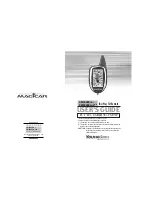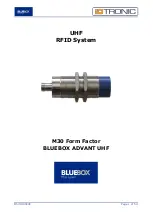13
Manual Manifold
2006230.03
2.5 Installation check
2.5.1 Ensure that all tailpipes are connected to the
gas cylinders and manifolds on both sides and that the
restraining chains are secure around the cylinders.
2.5.2 Isolate the panel from the pipeline by closing
the line valve ‘A’ shown in
figure 8
.
2.5.3 Using one cylinder per side, slowly pressurise
the control panel
(see section 4.6 - Cylinder operation)
.
The bank content gauge should indicate full cylinder
pressure. The distribution system pressure gauge
on the regulator (adjust as necessary, see section
3.3.2) should read typically as per
table 5
(Section 4 -
Principle of Operation)
.
CAUTION: If the control panel is used as a
emergency reserve manifold (ERM) it is recommended
to set the line pressure at least 0.2 bar below the
main supply source pressure at full design flow to
ensure the emergency manifold does not supply the
pipeline during normal primary source operation.
2.5.4 Check for leaks. Now ensure all bank cylinders
are closed.
2.5.5 Slowly open the test point valve ‘C’, see
figure
8
. The duty bank of cylinders should drain to typically
14-25 bar depending on the contact gauge switch point
(see table 2)
. After which the contact gauge should
trigger. This will send a signal to notify that cylinders
are empty and require changing. If the control panel
is not currently connected to an alarm, this can be
checked with a multimeter across the contacts which
will change from a closed to an open circuit.
3. Commissioning
3.1 General
Commissioning of the control manifold must be
carried out in full after initial installation. The object
of the commissioning procedure is to ensure that
all components are serviceable and that the overall
system is operable and set to the correct distribution
pipeline pressure. Suitably qualified competent
personnel who are familiar with this manual must
only undertake commissioning of the panel.
3.2 Preparation
3.2.1 Ensure that all tailpipes are connected to the
cylinders and manifolds on both sides and that the
restraint chains are secure around the cylinders.
3.2.2 Ensure that the outlet pipeline connection
from the manifold panel is connected to the
distribution system of the same gas service, and
isolation valve ‘A’
(see figure 8)
is present and closed.
3.2.3 Ensure that the panel’s isolation valve ‘C’
(shown in figure 8) is installed and in the closed
position.
3.2.4 Open all cylinder valves on the duty bank and
close all cylinders on the standby bank.
3.2.5 Check connections on the headers, tailpipes,
regulator and associated pipework for leaks.
3.3 Pressure Checks
3.3.1 Ensure that full gas cylinder pressure is shown
on the cylinder content gauges (see figure 8).
3.3.2 With Valve ‘A’ closed exhaust a small amount
of gas from the sampling outlet valve ‘C’. Check that
the pressure on the pipeline distribution pressure
gauge is typically as per
table 5
. Adjust as necessary.
Note - The line regulator is of the non-relieving type
as required for medical gas control. Any excess gas
pressure needs to be manually exhausted in order
to see the effects of reducing the regulator set point.
This is achieved by slightly opening the sampling
outlet isolation valve ‘C’ to produce a gentle bleed
from the panel.
3.3.3 Complete the steps in
section 4.4
- Procedure
to prime the control panel, to bring the unit online.
Figure 8 - Manual Manifold Controls
Supply line
valve ‘A’
Test valve ‘C’
Cylinder
contents
gauge
Optional cylinder bank valves
Line regulator
2.5.6 The installation must now be purged as per
HTM 02-01 for UK installations, or as per relevant
standards if installed outside the UK.


















